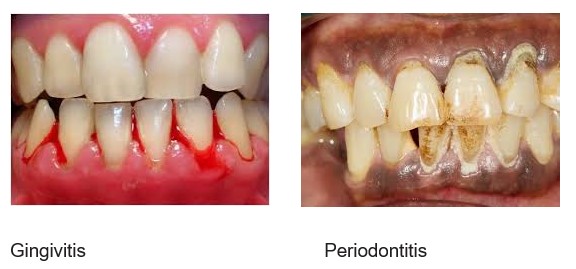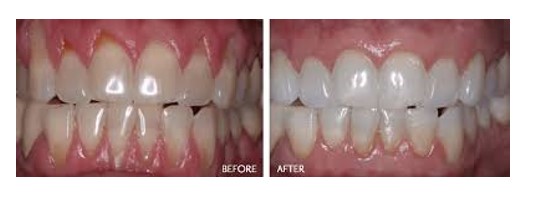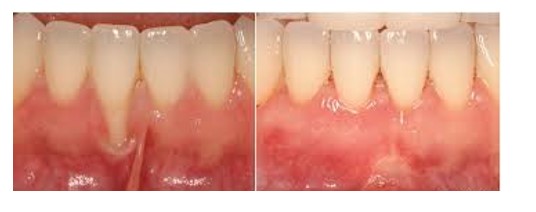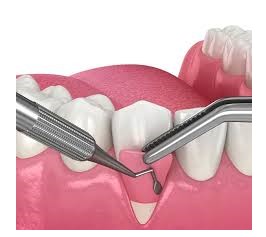
Periodontics is the specialized field of dentistry focused on the health of your gums and the supporting bone structures that anchor your teeth. Healthy gums are essential not just for a beautiful smile but also for preventing tooth loss, systemic inflammation, and serious health issues like heart disease and diabetes. At Toothbuddies, our periodontal care goes beyond routine cleanings to offer advanced treatments for gum disease, recession, bone loss, and soft tissue deficiencies.
Our team uses state-of-the-art technology including laser-assisted therapy, microsurgical instruments, and biocompatible regenerative materials to provide precise, minimally invasive care. Whether you’re dealing with early signs of gum disease or require surgical intervention, we offer personalized, evidence-based treatments to restore gum health, promote tissue regeneration, and enhance oral aesthetics.
Laser flap surgery is a cutting-edge treatment used to manage moderate to severe periodontitis (advanced gum disease). This procedure involves lifting a small section of the gum to access infected areas beneath. Using a high-precision laser, we clean out diseased tissue and sterilize the pocket, then reposition the gum to heal naturally. Compared to traditional methods, laser flap surgery offers:
Less bleeding and swelling
Faster recovery times
Reduced need for sutures
Greater comfort during and after treatment
Soft tissue surgeries improve gum health and smile aesthetics by reshaping or augmenting gum tissues. These procedures include:
Gum Grafting – Used to cover exposed tooth roots due to recession and reduce sensitivity.
Gingivectomy – Removes overgrown or inflamed gum tissue, often needed for gum disease or as a cosmetic procedure.
Frenectomy – Corrects restrictive frenum (lip or tongue tie) attachments, often contributing to recession or spacing.
These surgeries are performed with minimal discomfort using modern techniques and local anesthesia, ensuring precise results and aesthetic improvement.
Gum recession can lead to root exposure, making teeth sensitive to temperature and more prone to decay. We offer a range of treatments such as:
Desensitizing varnishes to relieve discomfort
Gingival grafts to rebuild lost tissue
Pinhole surgery – a less invasive option to treat mild recession without sutures
By addressing both the symptoms and the root cause, we help protect teeth and preserve the natural gum line.
Bone loss can result from periodontal disease, long-term tooth loss, or trauma. Bone grafting is a regenerative technique that restores the bone structure needed to support teeth or implants. We use:
Autografts (your own bone),
Allografts (donor tissue), or
Synthetic materials combined with growth factors to encourage new bone formation.
This procedure is essential for patients preparing for dental implants, correcting jawbone deterioration, or improving facial contours and function.
Laser & regenerative treatment options
Specialized care for medically complex cases
Emphasis on patient education & long-term prevention
Coordinated care with prosthodontists and implantologists
Comfort-focused techniques & sedation available
Periodontal flap surgery may be needed to treat certain gum diseases and conditions, such as gingivitis or periodontitis. This type of surgery is commonly known as gum surgery.
The procedure aims to treat the gum disease and any damage it may have caused by:
What is Gingivitis?
Gingivitis is a mild form of gum disease that can cause gum redness, swelling, and bleeding. Most often, gingivitis occurs due to poor oral hygiene, plaque, and tartar build-up. Professional treatment can reverse the condition.

What is periodontitis?
Periodontitis is a more severe form of gum disease in which gingivitis has worsened and advanced, leading to an inflammatory response that destroys bone and tissues.
During this inflammatory process, the gums begin to separate from the teeth. This causes spaces called pockets to develop, which in turn trap bacteria and lead to infection.
Types of surgical procedures
Before surgery, a dental surgeon might give the gums a deep clean. One procedure known as deep scaling can remove tartar and bacteria from teeth and gums.
Another procedure known as root planing can smooth the surfaces of the roots of the teeth, meaning that there are fewer places for tartar and bacteria to build up. This procedure also removes any tartar that is on the root.
Deep scaling and root planning usually occur at the same time.
Flap surgery
Flap surgery is especially helpful for people who have tartar deposits in deep pockets. The procedure involves lifting the gums off of the teeth to remove tartar build-up.
After the surgeon has cleaned the area and removed the tartar, they will stitch the gums into place to fit around the teeth. Sometimes, the bone may require reshaping during this procedure.
 Flap surgery before and after results
Flap surgery before and after results
Bone and soft tissue grafting
When the bone that surrounds the root of the tooth is damaged or destroyed, a person may need a bone graft. This procedure involves replacing the damaged bone with artificial bone graft powder. The goal of bone grafting is to hold the tooth in place and help it to regrow.
A lowered gum line, known as gingival recession, is caused by the loss of gum tissue and may require soft tissue grafting to reduce the risk of further damage. During this procedure, tissue from one part of the palate is removed and re-attached to the area where the gum has receded. Tissue grafting not only reduces the risk for further damage but also covers any exposed roots.

Guided tissue regeneration
During this procedure, a periodontist will place a small piece of mesh-like material between a person’s bone and gum tissue. The material prevents the gum from growing into space where bone should be, allowing the bone and connective tissue to regrow.

Other treatment options include:
Laser therapy: Laser therapy is used to reduce the size of pockets and restore damaged connective tissue.
Recovery
Once the planned dental surgery is complete, the surgeon will stitch the gums back into place, using fine thread stitches. The dentist will remove the stitches 7 to 10 days after surgery. Recovery times will depend on the extent of the procedure taking place.
Typically, people will require pain relief medications in the days after gum surgery. Again, the dentist will talk to the person about any recommended drugs before they leave the dental clinic.
A person’s gums will look and feel different after surgery. The gums and teeth will heal, tighten, and become firmer and stronger. Some people may have tooth sensitivity to hot or cold temperatures and may find relief by using desensitizing toothpaste.
Toothbuddies delivers quality dentistry with a personalized touch. Each patient is treated with the utmost care, compassion, empathy.
Copyright © 2025 All Rights Reserved.